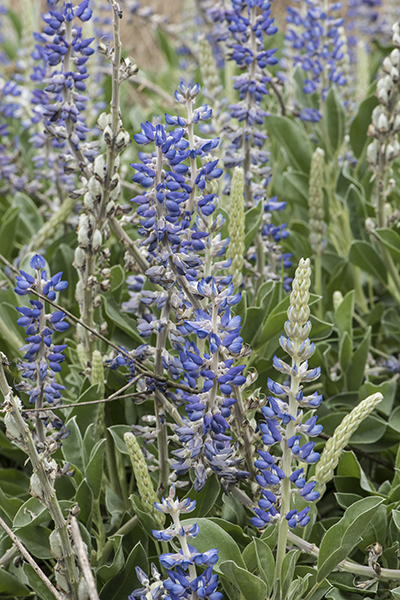Wednesday Wildflowers: Sundial and Skyblue Lupines
Today's Wednesday's Wildflower features two species of Lupine, the Sandhill Lupine, submitted by Roger Hammer, and the Sundial Lupine, submitted by Bill Berthet. Edited by Valerie Anderson.
Sandhill Lupine, Lupinus cumulicola
Text and photo by Roger Hammer, Dade Chapter
 |
| Sandhill Lupine, Lupinus cumulicola, by Roger Hammer |
From January to May each year the white sand scrub on the Lake Wales Ridge in Lake, Osceola, Polk, and Highlands Counties are adorned with the cheery blue flowers of the Florida endemic skyblue lupine (pronounced LOO-PIN). Some botanists consider it a synonym of Lupinus diffusus but others argue that L. diffusus differs by its habitat, range, prostrate to decumbent stems, orbicular-reniform (kidney-shaped) standard, and a nearly straight beak on the pods. The stems of Lupinus cumulicola are usually erect with gray-green, silky pubescent, elliptic leaves that average 2”–3” long and about 1” wide. The pods have a curved beak.
Lupinus is taken from lupus, or “wolf,” and alludes to the curious belief that these plants consumed soil fertility, when, in fact, they improve the soil with nitrogen-fixing bacteria. The species name cumulicola means “dweller on a heap or mound,” in this case, sand. It comes from the same root word for cumulus clouds that form billowing mounds in the sky. The seeds of some species were used in ancient Greece as a hallucinogen to psychoactively prepare people to commune with the dead.
The plant photographed was growing on a hill of white sand right alongside US-27 in Polk County in mid-January 2015. When in flower, it’s hard to miss. Bees are the principal pollinator.
Roger is a member of the FNPS Dade Chapter and is currently working on a new Falcon Guide titled Complete Guide to Florida Wildflowers, due to be released in Spring 2018. UPDATE: It is complete and available here. His other wildflower guides include Florida Keys Wildflowers (2004), Everglades Wildflowers (3nd edition, 2015), and Central Florida Wildflowers (2016).
__________________________________
Sundial Lupine, Lupinus perennis
Text and photos by Bill Berthet, Ixia Chapter
 |
| Sundial Lupine, 04-22-2016 Nassau Co, Bill Berthet |
Every spring, I look forward to the emergence of the wildflower Sundial Lupine, Lupinus perennis gracilis, in Nassau and Clay Counties. I look for eggs, larvae, and adult Frosted Elfin, Callophrys irus arsace, butterflies that only use this lupine as a host plant and sometimes nectar source.
 |
| The egg and larvae of the Frosted Elfin on Sundial Lupine, Bill Berthet |
Lupinus is from the latin word Lupus meaning “wolf” alluding to the belief that these plants robbed the soil. This is opposite of the truth, since Lupine actually helps to increase soil nitrogen.
 |
| Newly emerging Sundial Lupine 02-02-2017 Nassau Co., Bill Berthet |
Flowers are pea-shaped, bluish purple, rarely pink or white. Fruit is a hairy pod seed head that bursts open at maturity scattering the poisonous seeds. Native Americans drank a leaf tea made from this Lupine for nausea and internal hemorrhaging.
Bill Berthet is an avid butterfly and pollinator enthusiast, and has been landscaping his yard in Mandarin, Florida, with mostly native plants, bushes, vines, and trees to attract our N.E. Florida pollinators and birds for the past 15 years.
Read more about the imperiled Frosted Elfin and its lupine relationship in a previous blog by Bill here.
__________________________________




Comments